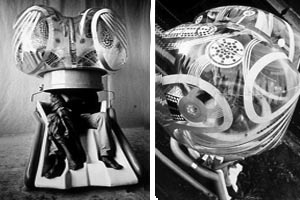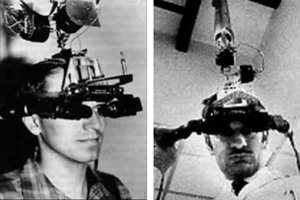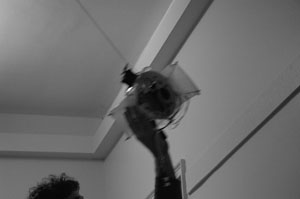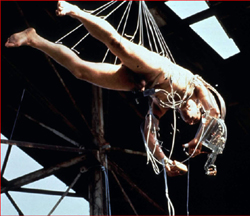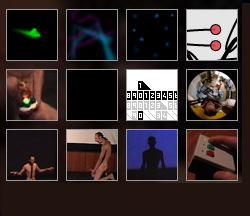Brian Diesel
From Collectivate Course Wikis
Research Overview
As a graduate student in a joint Media Study/Architecture program I am investigating the ways in which technology is leading to new sorts of spaces. I am currently researching three topics in support of my thesis project. Spatial-temporal architecture, which I refer to as space actively engaged, altering the perceptions through evolving transformation. Human Computer Interaction, in particular I focus on context aware computational devices able to join the body and environment Thirdly I am investigating Social aesthetics, the ways in which group interaction can become a perpetual factor, as an example I look to open source culture.
Research Bibliography
Research Schedule
Week 1: Valie Export: Fragments of the Imagination
Reading:
Muller, Roswitha. Valie Export: Fragments of the Imagination. Indianapolis Indiana University Press. 1994.
Response:
"In 1972 Export began work on what is perhaps the most significant series of her early photographic experiments, “Körperkonfigurationen in der Architktur (Body Configurations in Architecture, 1972-82). These images combine the female body and structural geometric concepts inspired by architectural forms. Accordingly, they explore the body as ornament and its accommodation with its Environment, as well as“visible externalization of internal states” in the body’s arrangements themselves. “Insertion,” “adaptation,” “addition,” and “elevation” are some of the principles which shape the body's adjustments to its architectural environs. Here the anagrammatically structure of Export's work is evident in some detail. She transposes these simple structural and architectonic principles onto the body, letting the body act as their complement. Yet upon closer scrutiny these cultural and geometric forms also prove to have their origin in the body, establishing in this way reciprocity of formal transpositions. And further, when placed in a narrative field, as in Invisible Adversaries, the aspect of externalized internal states is fore grounded as it releases the female subject's point of view to permeate geometric form with emotional content. Another whole cycle of Body Configurations in Architecture was shot in 1976 specifically for this film. Suzanne Widl, the film's protagonist, is the photographic object giving expression to her state of estrangement and alienation from her environment. An ornament at best, she demonstrates the qualities of “adaptation” and “insertion,” merging with the architectural forms in an anxious attempt to escape from a hostile Environment. And in further anagrammatically development, Fragmentary, an ostensibly non-narrative, experimental film concerned primarily with formal and structural investigations, is able to draw narrative import the cumulative power of transpositions attached to a brief sequence of Body Configurations in Architecture." (pg68)
Vallie Export uses Body Configurations in Architecture to transform her body into a conversation. Directly engaged with the built environment Export is able to bring personal meaning to the space. Through out the work Export's body becomes a tool to make apparent the oppressive minimal forms of the city. In these photos the body exemplifies an object which is at the mercy of existing architectural conditions, which in a broader sense are to be interpreted as social conditions. Similar to graffiti, Export's body is able to efface the Architectural limits and reconceived the body in urban space. Subsequently the body remains resistant, unable to conform to the space, challenging the assumed rationality of modernist architectural planning. This process deflates the body to the status of a decoration, a lifeless scar, in Valie Export's words, 'hides its wound'. At the same time, however, this configuration of body and environment also visualizes an internal state "without simply relegating the body to the status of “object” as we typically regard it passive, inert, acted upon.”(pg41)
I find the engagement between the body and architecture/city a very rich area to study. While Export uses these experiments to show oppression, I am more interested in how we can express ourselves through our environment. Through body configurations I am reminded of a project by the architecture firm NOX. NOX designs architecture that allow people to interact with there environment in a naturalistic and fluid manner. NOX promotes environments "as tools for constructing dynamic spaces where people can unpredictably and creatively interact with their environment." In their recent h2o pavilion NOX emphasize the motion of the interior space through the eliminating all strait/flat surfaces, then introducing computer controlled lights that change the "illumination of the interior through projection to create a hybrid fluid architecture."
Week 2: Expanded Cinema
Reading:
Youngblood Gene. Expanded Cinema. New York P.Dutton CO. 1970.
Response:
“When we say expanded cinema we actually mean expanded consciousness. Expanded cinema does not mean computer films, video phosphors, atomic light, or spherical projections. Expanded cinema isn't a movie at all: like life it's a process of becoming, man's ongoing historical drive to manifest his consciousness outside of his mind, in front of his eyes. One no longer can specialize in a single discipline and hope truthfully to express a clear picture of its relationships in the environment. This is especially true in the case of the inter media network of cinema and television, which now functions as nothing less than the nervous system of mankind.
At this point in the Palo cybernetic Age, the messages of society as expressed in the inter media network have become almost totally irrelevant to the needs and actualities of the organism. The situation is equivalent to one's own nervous system transmitting erroneous information about the metabolic and homeostatic condition of one's own body."
(pg 41)
Synaestheic Cinema is a platform that envelopes the senses creating a new modes consciousness and perception. Youngblood defines synaesthesis as "the harmony of different or opposing impulses produced by a work of art." (pg43) This form of cinema is not cinema as theater; this cinema is a dialog created through the evolution of active relationships; not a yes/no, in/out. Youngblood described the expanded cinema as space created through images where people lost track of the difference between their bodies and their environment. Through the participant’s awareness of space, time, and body, viewers are able to extend themselves into states of heightened consciousness. An Expanded Cinema event thrives on the presence of audience, real-time manipulation, accidents, and mistakes. This expanded cinema not only involves a multi-sensory experience, but a complex way of seeing and creating.
Gene Youngblood notion of Expanded Cinema is analogous to a technologically induced transgenic/hallucinogenic state. At that time there where several Architects working on similar tenets. Examples are Archigram (http://www.archigram.net) , Superstudio (http://www.designmuseum.org/design/index.php?id=51) and Haus Rücker Co (http://www.ortner.at/C_HRe.html).
Gene Youngblood's definition of expanded cinema was quite contrary to Valie Export. Export refers to expanded cinema as "the expansion of the commonplace form of film on the open stage or within a space, through which the commercial-conventional sequence of film making – shooting, editing (montage), and projection." Youngblood calls of a technological mediation and Export uses non-media based performance.
top
Week 3: Technologies of Cooperation
Reading:
Saveri, Andrea. Rheingold, Howard. Vian, Kathi. Technologies of Cooperation, Institute for the Future.Palo Alto CA. January 2005.
Response:
"What we are witnessing today is thus the acceleration of a trend that has been building for thousand of years. When technologies like alphabets and Internets amplify the right cognitive or social capabilities, old trends take new twists and people build things that never before could be built."(pg8)
New communication technologies are allowing for advanced forms of social interaction. With the aid of technological communication the bandwidth of language has become amplified, opening new channels of communication. Howard Rheingold's examples of the Technologies of cooperation are allowing groups to interact with higher degrees of specification, regardless of physical location. As an example the paper uses a chat room focused around the BMW 2002 when one of the participants wants to discuss BMW in general he is cited as being out of line.
While computational technologies like mathematics and graphic user interface have aided in cognition; networking has aided in collaboration. Mobile and pervasive communications devices aid group dynamisms and social group formation. It has become clear through the recent growth of social software that the role of the computer is changing our practices. Technologies of Cooperation shows that tasks once inconceivable at the individual level may now become realized through communication and task dispersion.
As an outline the report concludes with seven guidelines to drive technological cooperation: (1) Shift focus from designing systems to providing platforms. (2) Engage the community in designing rules to match their culture, objectives, and tools; (3) encourage peer contracts in place of coercive sanctions by distant authority when possible. (4)Learn how to recognize untapped or invisible resources. (5)Identify key thresholds for achieving “phase shifts” in behavior or performance.(5)Track and foster diverse and emergent feedback loops. (6)Look for ways to convert present knowledge into deep memory. (7)Support participatory identity. Technologies of Cooperation Map
Week 4: Bowling Alone
Reading:
Putnam Robert D. Bowling Alone. Simon & Schuster. New York. 2000
Response:
"Where as physical capital refers to physical objects and human capital refers to the properties of individuals, social capital refers to connections among individuals – social networks and the norms of reciprocity and trustworthiness that arise from them. In that sense social capital is closely related to what some have called “civic virtue.” The difference is that “social capital” calls attention to the fact that civic virtue is most powerful when embedded in a sense network of reciprocal social relations. A society of many virtuous but isolated individuals is not necessarily rich in social capital."(pg)
Robert Putnam's develops his thesis in Bowling Alone that technological, social, and economic changes within the past three decades have depleted the national stocks of "social capital". Throughout every stratum of society, the American citizen has become increasingly complacent and disengaged from both the civil and social spheres. As a benchmark Putnam's uses the case more people now actually bowl alone than in organized leagues or teams; a game created for socializing. This lack of social capital is causing Americans to becoming increasingly distrustful of one another. As cause Putnam cites: both spouses entering the workforce, mobility and other "demographic transformations" such as urban sprawl, and technology transforming leisure, as the recent lifestyle changes promoting these social ailments. The general distrust created has lead to a degraded concept of "civil society", which is a precondition for democracy and democratization. Social interaction enables people to build communities, to commit themselves to each other, and to knit the social fabric. 'A sense of belonging and the concrete experience of social networks (and the relationships of trust and tolerance that can be involved) can bring great benefits to people. Through the statistics the Putnam creates a vivid image of the social crisis occurring.
While the statistics in Bowling Alone where shocking, Putnam left off far too much research about the formation of Internet communities, and new forms of social interaction and social softwares. While Putnam did briefly touch on the subject with the statement 'My hunch is that meeting in an electronic forum is not the equivalent of meeting in a bowling alley--or even in a saloon(pg) More research into this field would have shored up the author's points.
Week 5: Me++
Reading:
Mitchell William . Me++. The MIT Press. Boston, MA. 2003
Response:
“Embedded within a vast structure of nested boundaries and ramifying networks, my muscular and skeletal, physiological, and nervous systems have been artificially augmented and expanded. My reach extends indefinitely and interacts with the similarly extended reaches of others to produce a global system of transfer, actuation, sensing, and control. My biological body meshes with the city; the city itself has become not only the domain of my networked cognitive system, but also -- and crucially -- the spatial and material embodiment of that system.” (pg20
ME++ The Cyborg Self and the Networked City, (William Mitchell) describes the social transformations occurring through technology since Marconi's first radio transmission. The increasing size of networks and scaling down of the apparatus for transmission and reception are changing are nodes of communication. The changes we are experiencing through wireless technologies are transforming our relationships with one another. "A world with decreased borders and more connections require s to reimagine and reconstruct our environment and reconsider the ethical foundations of design, engineering and planning practice." discontinuous, asynchronous global angoras,” Mitchell foretells of a city where bits(of information) and atoms(of physical matter) begin to converge, once entirely two distinct separate realms.
"They would say that I -- like most urbanities today -- get companionship, aid, support, and social control from a few strong social ties and many weak ones. These ties, which might manifest themselves, for example, as the entries in my cell phone and email directories, establish social networks." (pg) In the past, such networks would mostly have been maintained by face-to-face contact within a contiguous locality -- a compact, place-based community. Today, they are maintained through a complex mix of local face-to-face interactions, travel, mail systems, synchronous electronic contact through telephones and video links, and asynchronous electronic contact through email and similar media. They are far less dense, and they extend around the world, coming to earth at multiple, scattered, and unstable locations. Communities are becoming fragmented and expansive. People connect to each other via the Internet and other media regardless of location. Social softwares such as myspace and facebook begin creating these local networks based on personal relationships not physical space. top (http://wiki.critical-netcultures.net/wiki/index.php/Brian_Diesel)
Week 6: Man Machine Computer Symbiosis
Reading:
Licklider, J.C.R. Man Machine Computer Symbiosis. IRE Transactions (now IEEE) . pages 4-11 1960.
Response:
"The fig tree is pollinated only by the insect Blastophaga grossorun. The larva of the insect lives in the ovary of the fig tree, and there it gets its food. The tree and the insect are thus heavily interdependent: the tree cannot reproduce wit bout the insect; the insect cannot eat wit bout the tree; together, they constitute not only a viable but a productive and thriving partnership. This cooperative “living together in intimate association, or even close union, of two dissimilar organisms is called symbiosis." [27]
“Man-computer symbiosis” is a subclass of man-machine systems. There are many man-machine systems. At present, however, there are no man-computer symbioses. The purposes of this paper are to present the concept and, hopefully, to foster the development of man-computer symbiosis by analyzing some problems of interaction between men and computing machines, calling attention to applicable principles of man-machine engineering, and pointing out a few questions to which research answers are needed. The hope is that, in not too many years, human brains and computing machines will be coupled together very tightly, and that the resulting partnership will think as no human brain has ever thought and process data in a way not approached by the information-handling machines we know today." [pg 9]
Licklider's describes a man–machine coupling in which the computers “facilitate formulative thinking”, and man and computer cooperate in making decisions and controlling the outcome of complex situations. There are inherit differences in calculating between man and computer, and there ability to mutually benefit from one another’s particularities, as an example he uses this analogy of the fig tree and Balstophaga insect which depend on one another for a mutual co-existence. The computer is best at making deliberation from a set of linear references where man is able to derive decisions based on intuition. Unlike many of his contemporaries, such as AI practitioners, Licklider never felt that man's reason would not be superseded by a computer-based higher intelligence. Lickliders’ notion was that a computer will become the collaborative partner in the creative process, made possible through the ease of interaction and high level communication. Licklider examined his typical day and found that 85% was spent retrieving/ receiving information and when that task was complete, deliberation was quite quick and easy. In this retrieving stage the computer would be most mutually beneficial.
Week 7: Virtual Art
Reading:
Grau,Oliver. Virtual Art The MIT Press. Cambridge Massachusetts. 2003.
Response:
"The phenomenon of telepresence transforms spatial experience as we know it, which was hitherto determined by physical experience. The direct experience of location, dependent on the body, is primarily responsible for epistemic experience, but then gives way partially to a telepistemology that is without subject. However, inner and visual distances are essential prerequisites for the experience of art and the world in general. Since the eighteenth century, aesthetic theories have regarded distance as a constitutive element of reflection, self-discovery, and the experience of art and nature. These stressed that the inner distance of the observer must be finely balanced so that the view of the whole and details are equally accessible. The experience of distance dose not reject sensory experience or emotions per se, as does religions or myth, but it relies on their relative integration in the entirety of human experience. Experience of propagandistic, orgiastic, or pornographic elements is in direct contrast to conscious experience grounded in aesthetic distance. Here, distance is understood as gaining an overview and not merely in the sense of physical separation from the object. More than perhaps any other thinker, [Ernest Cassirer] reflected on the power of distance for intellectual productivity and creating awareness. In Individuum and Kosmos, Cassirer proposes that distance constitutes the subject and is solely responsible for producing the "aesthetic image space", as well as the "space of logical and mathematical thought." Three years later [Aby Warburg] stressed the intellectual, awareness-heightening power of distance and placed this “original act of human civilization," in the introduction to his Mnemosyne-Atlas. The result of this physical and psychological distancing from the phenomenon is a conceptual space or Denkraum: the precondition for awareness that an object is distance and separate from the conscious subject. It seemed to Warburg at the beginning of the twentieth century that that this was already threatened by the sudden proximity created by the invention of the telegraph." (pg 286)
Week 8: The Computer as a Communication Device
Reading:
Licklider J.C.R. The Computer as a Communication Device. Originally Published: Science and Technology. [1]. 1968
Response:
But to communicate is more than to send and to receive. Do two tape recorders communicate when they play to each other and record from each other? Not really - not in our sense. We believe that communicators have to do something nontrivial with the information they send and receive. And to interact with the richness of living information -- not merely in the passive way that we have become accustomed to using books and libraries, but as active participants in an ongoing process, bringing something to it through our interaction with it, and not simply receiving from it by our connection to it... We want to emphasize something beyond its one-way transfer: the increasing significance of the jointly constructive, the mutually reinforcing aspect of communication - the part that transcends 'now we both know a fact that only one of us knew before.' When minds interact, new ideas emerge. We want to talk about the creative aspect of communication."[pg40]
To appreciate the import ante the new computer-aided communication can have, one must consider the dynamics of “critical mass,” as it applies to cooperation in creative endeavor. Take any problem worthy of the name, and you find only a few people who can contribute effectively to its solution. Those people must be brought into close intellectual partnership so that their ideas can come into contact with one another. But bring these people together physically in one place to form a team, and you have trouble, for the most creative people are often not the best team players, and there are not enough top positions in a single organization to keep them all happy. Let them go their separate ways, and each creates his own empire, large or small, and devotes more time to the role of emperor than to the role of problem solver. The principals still get together at meetings. They still visit one another. But the time scale of their communication stretches out, and the correlations among mental models degenerate between meetings so that it may take a year to do a week’s communicating. There has to be some way of facilitating communication among people without bringing them together in one place.[pg34]
Written in 1968 Licklider forecasts the disassociates problems and benefits with asynchronous computer aided communications. "In a few years men will be able to communicate more effectively through a machine than face to face." At the time this was a startling notion. Licklider sees computer mediated communication as a way to bring ideas together while avoiding personal internal conflicts. Through extended communication the distribution of intellectual resources can extend cooperative working and promote coherence between geographically removed groups. Ideally Licklider describes the use of a "store-and-forward" in which communications are archived and distributed similar to the functions of the Internet toady. While most computer scientists at the time were concerned with data and processing Licklider was able to envision a greater potential for computing machinery.
I feel that still today Universities and the Computer industry only delves into the technical capability and possibilities of computation, without considering the social implications of our extended communications.
Week 9: Spring Break
Spring Break
Week 10: The Cathedral and the Bazzar
Reading:
Raymond, Eric. The Cathedral and the Bazzar version 3.0. avaliable:[2] .2000
Response:
"In fact I think Linus's cleverest and most consequential hack was not the the construction of the Linux kernel itself, but rather his invention of the Linux development model. When I expressed this opinion in his presence once, he smiled and quietly repeated something he has often said: "I'm basically a very lazy person who like to get credit for things other people actually do." Lazy like a fox. Or, as Robert Heinlein famously of one of his characters, too lazy to fail."[pg.]
"There is another kind of skill not normally associated with software development which I think is as important as design cleverness to bazaar projects-and it may be more important. A bazaar project coordinator or leader must have good people and communication skills.
This should be obvious. In order to build a development community, you need to attract people, interest them in what you are doing, and keep them happy about the amount of work they're doing. Technical sizzle will go a long way towards accomplishing this, but it's far from the whole story. The personality you project matters, too.
It is not a coincidence that Linus is a nice guy who makes people like him and want to help him. It's not a coincidence that I'm an energetic extrovert who enjoys working a crowd and has some delivery instincts of a stand up comic. To make the bazaar model work, it helps enormously if you have at least a little skill at charming people. "[19]
The approach to working with volunteers is quite different from the completive model. Where "resource marshaling" is a defensive act volunteers are able to use the attack approach. In contrast to the conventional management structure, volunteer based systems tend to be self organizing, and efficient, the "social meilu selects ruthlessly for competence."
I think play is one of the most important aspects of the open source development model. When people are free creation becomes innate, the open source model is found on this notion. People enjoy a challenge, and take pleasure in a task when it is optimally challenging. "Free as in freedom, not free as in free beer." Is able to be applied to software development because of the lack of resources. Once a physical component is added there need to be a way to fund or mutual reward for undertaking the project. As an architect this is an area I would like to explore.
Week 11: Design In The Bubble
Reading: Thackra, John Design in the Bubble.
ResponseDiesel11
Week 12: Everyware
Reading:
Greenfield, Adam. Everyware: The dawning age of ubiquitous computing. New Riders Berkley CA. 2006
Response:
" By its very nature, a computing so pervasive and so deeply intertwined with everyday life will exert a transformative influence on our relationships with ourselves and with each other. In fact, wherever it appears in the world, everywhere (Ubiquitous computing) is always already of social consequence. It can hardly be engaged without raising issues of trust, reputation, credibility, status respect, and the presentation of self. Take JAPELAS, a recent Tokushima University project that aims to establish the utility of ubiquitous technology in the classroom -in this case, a Japanese language classroom . One of the complications of learning to speak Japanese involves knowing which of the many levels of politeness is appropriate in a given context, this is just what JAPELAS sets out to teach. The system determines the "appropriate" expressions by trying to assess the social distance between interlocutors, their relative status, and the overall context of their interaction; it then supplies the student with the chosen expression in real time." [pg 84]
Research Presentation
Download presentation slides (pdf) Notes on Presenting
Images from the Presentation:
From the Presentation:
Information technologies have become part of our habitat. Computers, electronic media are no longer tools of the military and industry, but also, a means of perception and self expression. We are just beginning to create new systems technological, social, political and economic that have the ability to adapt to people, reversing the role of subservient machine. What would happen if the space we inhabit where capable of dealing with adoration or the subtlety of human interaction became just as captivating as latest fantastic video game?
Expanded Cinema
“When we say expanded cinema we actually mean expanded
consciousness. Expanded cinema does not mean computer films, video
phosphors, atomic light, or spherical projections. Expanded cinema is not
a movie at all: like life it's a process of becoming, man's ongoing historical
drive to manifest his consciousness outside of his mind, in front of his
eyes. One no longer can specialize in a single discipline and hope
truthfully to express a clear picture of its relationships in the environment.
This is especially true in the case of the inter media network of cinema
and television, which now functions as nothing less than the nervous
system of mankind. At this point in the Palo cybernetic Age, the messages
of society as expressed in the inter media network have become almost
totally irrelevant to the needs and actualities of the organism. The
situation is equivalent to one's own nervous system transmitting
erroneous information about the metabolic and homeostatic condition of
one's own body." Gene Youngblood Expanded Cinema (pg 41)
Open Source Architecture
Open source when applied to software refers to an accessible source code
which is accessible to all, and freely distributed as long as it remains
equally open; that allows for modification and deviation.
Similarly an open source architecture requires a framework in which the
distinction between “those who design” and “those who use” is replaced
by a operatically system that encourages a constructed project to be
constantly patched or preformed.
The Architecture of Participation
"What we are witnessing today is thus the acceleration of a trend that has been
building for thousand of years. When technologies like alphabets and Internets
amplify the right cognitive or social capabilities, old trends take new twists
and people build things that never before could be built."
Howard Rheingold, Technologies of Cooperation
This cooperative “living together in intimate association, or even close union,
of two dissimilar organisms” is called symbiosis.” JCR Licklider
“the most difficult challenges for designers of electronic objects now lie not in technical and semiotic functionality, where optimal levels of performance are already attainable, but in the realms of metaphysics, poetry and aesthetics where little research has been carried out” (Hertzian Tales). If we assume that such systems in architecture could deal with the practical and functional requirements of constructed spaces then the beauty in design comes from the poetries of those who use/implement/remake it. A system that allows people themselves to create their own spaces and collectively build a social space -- that would be more conceptually “open”.
Remix outmoded sites as the locus for an open space project, encouraging user to create a new interactive community garden through electronic media.
Research Direction
Links
Research Links - Culture
- Silophone
- GameboyHacking
- kid-beyond
- infiltration
- Electro graff
- woostercollective
- Hacker Manifesto
- BowlingAlone
- Crafting the Public Realm
- The Practice of Everyday Life
- Expanded Cinema by Gene Youngblood
- The Young Foundation
- [3]
Research Links - Theory
- Paskian_Enviroments
- Technologies of Cooperation by Howard Rheingold
- Architecture of Conversation Thoery
- Pask Video Archive
- Archis
- ArchitectureOfInteraction
- Nature Futre Computing
- Hyperbody research Group
- [4]
Research Links - Practice
- UX-design net
- Interaction Design
- Thackara,John In The Bubble Designing In a Complex World.
- Virtual Art by Oliver Grau
- Open Source Media Architecture
- Hardspace, spftspace and the possibilites of open souce architecue PDF
- Aether Architecture
- Hypersurface Architecture
- Herman Hertzberger Diagoon House
- Brand Central Station
- The Berkman Center for Internet and Society
Research Blogs
- pasta and vinegar
- Doors of Preception weblog
- Jesse James Garrett's Hidden Agenda
- [5]
- Notes From the Technology Underground
- ambidextrou
- BlackbeltJones
Symposiums, Conferences and Festivals

